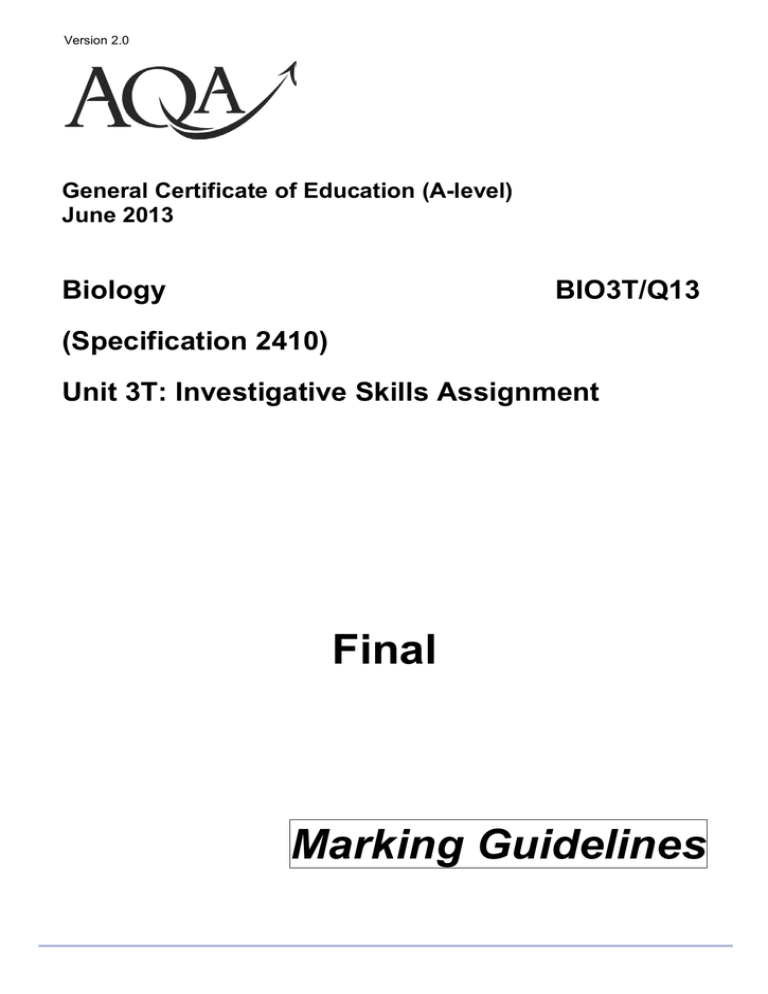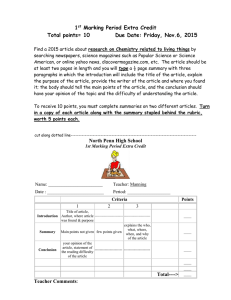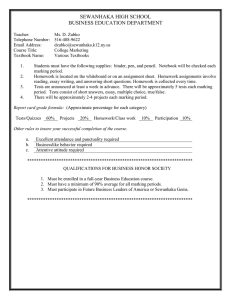
Version 2.0
General Certificate of Education (A-level)
June 2013
Biology
BIO3T/Q13
(Specification 2410)
Unit 3T: Investigative Skills Assignment
Final
Marking Guidelines
Mark schemes are prepared by the Principal Moderator and considered, together with the
relevant questions, by a panel of subject teachers.
Further copies of this Mark Scheme are available from: aqa.org.uk
Copyright © 2013 AQA and its licensors. All rights reserved.
Copyright
AQA retains the copyright on all its publications. However, registered schools/colleges for AQA are permitted to copy material
from this booklet for their own internal use, with the following important exception: AQA cannot give permission to
schools/colleges to photocopy any material that is acknowledged to a third party even for internal use within the school/college.
Set and published by the Assessment and Qualifications Alliance.
The Assessment and Qualifications Alliance (AQA) is a company limited by guarantee registered in England and Wales (company number 3644723) and a registered
charity (registered charity number 1073334).
Registered address: AQA, Devas Street, Manchester M15 6EX.
FINAL Marking Guidelines – General Certificate of Education (A-level) Biology – BIO3T/Q13 – June
2013
Guidance for teachers marking Biology ISAs
Final Marking Guidelines must be used to mark students’ work.
General principles
In general, you are looking for evidence that the student knows and understands the point
required by the Marking Guidelines.
It is important to mark what the student has written, not to assume what may have been intended.
It is also important to make sure that a valid point is in the correct context. Individual words or
phrases where the overall answer does not apply to the question asked should not be credited.
Conventions
The following conventions are used in the Marking Guidelines.
•
•
•
•
•
•
•
A semicolon (;) separates each marking point
An oblique stroke (/) separates alternatives within a marking point
Underlining of a word or phrase means that the term must be used
For example anaphase, the term must appear
For example ...... and ........, both items must be present for a mark
Brackets are used to indicate contexts for which a marking point is valid. This context may
be implied by a student's answer
'Accept' and 'reject' show answers which should be allowed or not allowed
Additional instructions are shown in the comments column
‘Max’ refers to the maximum mark that can be awarded for a particular question or part
question.
The Marking Guidelines show the minimum acceptable answer(s) for each marking point. A
better, more detailed, or more advanced answer should always be accepted, provided that it
covers the same key point.
Marking Guidelines cannot give every possible alternative wording - equivalent phrasing of
answers should be accepted. For example, ‘the water potential is higher in the cells’ is equivalent
to ‘the water potential is less negative in the cells’. It is, however, important to be sure that the
minimum requirement of the Marking Guidelines is met and that the point is made
unambiguously.
Converse answers are normally acceptable, unless the wording of the question rules this out. For
example, 'the water potential is lower in the solution’ is an acceptable converse of ‘the water
potential is higher in the cell’.
Very occasionally, a student will give a biologically correct answer that is not covered in the
Marking Guidelines. If it is equivalent in standard to the Marking Guideline answers, it should be
credited. In this case, write the word ‘valid’.
All marking points are awarded independently, unless a link between points is specified in the
Marking Guidelines.
3
FINAL Marking Guidelines – General Certificate of Education (A-level) Biology – BIO3T/Q13 – June
2013
The mechanics of marking
Always mark in red ink. Make sure that some red ink appears on every page on which the student
has written.
For each mark awarded, put a tick close to the marking point. In all cases, a tick should equal one
mark and the total number of ticks should match the mark totals in the margins. The total mark for
each part answer should be written in the right hand margin.
Put a cross against incorrect points. It is helpful to indicate omissions of key words or incomplete
answers with a Λ symbol, and to highlight irrelevancies or contradictions by underlining. It is also
helpful to write brief comments to explain the reason for awarding or withholding a mark when the
answer does not obviously match the Marking Guidelines.
When marking answers with many marking points, the points will be numbered. The points do not
have to appear in the student’s response in the order in which they appear in the Marking
Guidelines. The appropriate number must be placed alongside the tick. This helps to clarify
where a specific point has been awarded and makes moderation much easier. It also helps to
avoid awarding the same point twice.
Disqualifiers A correct point should be disqualified when the student contradicts it in the same
answer. Indicate this on the script by 'dq'. If a tick has already been placed against a valid point,
ensure that it is clearly deleted. Note that there is no penalty for incorrect points which are not
contradictory, or for surplus or neutral information.
The list rule When a question asks for a specific number of points, and the student gives more,
the general rule is that any wrong answer cancels a correct answer. For example, if a question
asks for two points and three answers are given, two correct and one clearly wrong, the mark
awarded is one, whatever the order of the answers. This prevents students from gaining full
marks from a list of right and wrong answers.
Example:
Name two substances that are produced in photosynthesis.
Answer
Marks
(2 marks)
Comment
Oxygen, glucose
2
Both correct
Oxygen, carbon dioxide
1
One correct, one incorrect
Carbon dioxide, oxygen,
glucose
1
Carbon dioxide is clearly incorrect and
cancels one of the marks
Oxygen, glucose, water
2
Regard water as a neutral point. It is
not worth a mark but it is not incorrect
Two or more correct points on the same answer line should be credited.
'Neutral' points, i.e. ones which are not creditworthy but not actually incorrect, should not negate
a correct answer.
Spelling Reasonably close phonetic spellings should be credited. However, any misspelling of
technical terms which can easily be confused, such as intermediate between ‘mitosis’ and
‘meiosis’, should result in the relevant marking point being withheld. Terms like this will be
indicated in the comments column in the Marking Guidelines to show that misspellings must not
be credited.
4
FINAL Marking Guidelines – General Certificate of Education (A-level) Biology – BIO3T/Q13 – June
2013
BIO3T/Q13 TASK
Before you mark any work, please make sure that you have read Guidance for teachers
marking Biology ISAs on pages 3 and 4 of these Marking Guidelines.
Stage 1 – Marking of table showing raw data
Marking Guidance
Mark
Comments
Student’s own raw data presented clearly with
full description of dependent variable, e.g.
‘Number of stomata in field of view’;
1
This may be recorded either by
full heading or in the title to the
table. ‘Number of stomata’ is
insufficient
Data from different leaves clearly identified;
1
Do not award if data for 3 leaves
not included or if data for only
one field of view has been
recorded
Total
2
The Candidate Results Sheet: Stage 1 is required for moderation and must be attached
to the ISA test.
5
FINAL Marking Guidelines – General Certificate of Education (A-level) Biology – BIO3T/Q13 – June
2013
Stage 2 – Marking of calculations and graph
Marking Guidance
Mark
Comments
1. Mean values for all 3 leaves calculated
correctly;
1
Do not credit if only one field of
view recorded for each leaf
2. Standard deviations for all 3 leaves
calculated correctly;
1
Do not credit if only one field of
view recorded for each leaf
3. Graph has leaf (number) on x-axis and
mean number of stomata on y-axis;
1
Accept other ways of showing
there are 3 leaves
4. Appropriate scale selected for y-axis;
1
Scale should allow for both
accurate plotting and reading the
graph
5. x-axis and y-axis appropriately labelled as
‘Leaf’ and ‘Mean number of stomata’;
1
‘Mean number of stomata’ is
minimum requirement for y-axis
6. Data presented as a bar chart with 3 bars of
same width and not touching;
1
Reject if more than or fewer than
3 bars shown
7. Mean values plotted accurately;
1
Accept plotting of student values
even if calculated incorrectly
If ICT has been used, it should be
possible to read the height of the
bars with appropriate precision
8. Standard deviation bars plotted accurately
both above and below the bar height;
Total
1
Accept plotting of student values
even if calculated incorrectly
8
The Candidate Results Sheet: Stage 2 is required for moderation and must be attached
to the ISA test.
6
FINAL Marking Guidelines – General Certificate of Education (A-level) Biology – BIO3T/Q13 – June
2013
BIO3T/Q13 Section A
Question Marking Guidance
1
Mark
Genetically identical / same growing
conditions;
1
Comments
Accept different plants have
different DNA/
alleles/genes/genotypes
Accept named growing condition
2
Enough to get a representative mean /
so anomalies can be identified / until
concordant readings;
1
‘To calculate a mean’ is
insufficient
Reject the idea of discounting or
ignoring anomalies
Accept reference to running mean
to see when mean stabilises
3
Eyepiece x objective (lenses);
1
4
Use of a tally / repeated the count /
change depth of focus to check all
stomata are counted / avoid areas with
air bubbles / avoid areas where
epidermis is folded / precaution which
accounts for stomata that are only
partly in field of view;
1
5
1. Density/number of stomata may
not be uniform;
1 max 1. Accept there could be
more/fewer stomata at the edges
2. Reject reference to observer
bias
2. To get results representative of the
whole leaf/epidermis;
6
2
1. Appropriate statement that
compares means;
2. Appropriate statement that uses
standard deviations;
7(a)
1.
Use graph paper/grid;
2.
Count squares;
1. E.g. the mean number of
stomata per field of view varies in
different leaves
2. E.g. comparison of variation
about the means
2 max Mark as a pair
OR
3. Use ruler/mircrometer/graticule/
measure radius/measure diameter;
4.
Accept as a minimum ‘multiply the
two lenses together’
Use 𝜋𝑟 2 ;
7
FINAL Marking Guidelines – General Certificate of Education (A-level) Biology – BIO3T/Q13 – June
2013
7(b)
4
1. Measure leaf area;
2. Detail e.g. draw around leaf on
graph paper and count squares;
2. An alternative is to find the
mass of a piece of paper the
same size as the leaf. Only credit
this idea if, in point 4, the mass of
a piece of paper equivalent to the
field of view is also found
3. Use mean number of stomata per
field of view;
4. Multiply this (mean number of
stomata per field of view) by leaf
area divided by area of field of
view;
If given, the formula of
Mean no. of stomata × leaf area
Area of field of view
achieves points 3, 1 and 4
8
1. Less water loss / less transpiration
/ less evaporation / more water
conserved;
2
2. (Beneficial because) xerophytes
are adapted to areas where water
is scarce / xerophytes live in areas
where water is scarce;
Total marks for Section A
8
15
FINAL Marking Guidelines – General Certificate of Education (A-level) Biology – BIO3T/Q13 – June
2013
BIO3T/Q13 Section B
Question Marking Guidance
9
Mark
Any three from:
Comments
3 max
1. Light;
2. Carbon dioxide;
3. Type of soil;
4. Minerals / nutrients;
4. Accept named example
5. Water (in soil);
6. Humidity (of air);
7. pH (of soil)
8. Planting density;
8. Idea of equally spaced
10
Already levelled out (before 20 oC);
1
11
Young leaves (may) have different
number of stomata (per mm2) / number
of stomata (per mm2) changes during
development (of leaf);
1
Accept reference to density
of stomata
12
Any two from:
2 max
Points 1 and 2 need context
of ‘more’
1. Molecules have more kinetic energy;
1. Accept KE
2. Faster diffusion of water / more
evaporation of water (as
temperature increases in leaf);
2. For this point, diffusion
must relate to movement of
water
3. Steeper water potential/diffusion
gradient;
13
1. The more recent the sample the
greater the concentration;
2
1. This could be expressed
by reference to time e.g.
‘concentration has increased
since 25 000 years ago’
2. Increases most in last 5000 years /
more or less constant/slight increase
between 30 000 and 15 000 years
ago;
14
1. Variation in data / spread of data;
Accept converse
2
2. Around the mean;
1. Reject references to range
e.g. ‘range of data’
Both marks are possible in
the context of using the data
15
1. Yes as pine leaves not in organic
matter of the same age;
2. No as organic matter would be the
same age as the pine leaves;
9
1 max
Accept either approach
FINAL Marking Guidelines – General Certificate of Education (A-level) Biology – BIO3T/Q13 – June
2013
16
Can get more CO2 for photosynthesis;
17
Any three from:
1
More CO2 enters leaf is
insufficient. Accept lightindependent (reaction) as
equivalent
3 max
1. (Overall data show) negative
correlation;
1. Do not allow description
of correlation because in
question stem
2. Little change in number of stomata
in last 10 000 years;
3. Small sample size;
4. Only one species studied;
5. Other factors/named factor may
have affected number of stomata;
18
6. Evidence does not support the
conclusion between 30 000 and
25 000 years ago/between 5000
years ago and present day;
6. Accept reference to either
one of these age ranges
7. Appropriate reference to standard
deviations (in comparing means);
7. E.g. no overlap between
15 000 and 10 000 years ago
Any three from :
3 max
1. Thick cuticle;
2. Accept other ways of
describing ‘small’, e.g.
‘needle-like’
2. Small leaves/low surface area;
3. Hairy leaves;
4. Sunken stomata;
5. Rolled leaves;
Total marks for Section B
10
19


